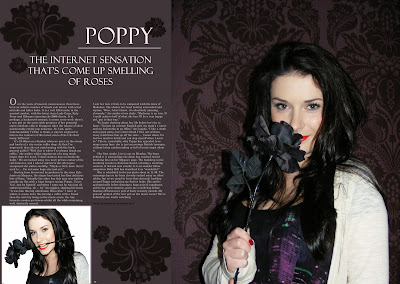For the final design of my double page spread I chose a style in-keeping with the artist presented and the language I used in the article. When I chose a setting for my image I used an existing background of purple with flowers with the artist in mind, as her name was Poppy. I also chose to have her holding a black rose as this has connotations of femininity and beauty, but the black made the look more modern. I chose a light pink font to co ordinate with the background and continue the theme of girlishness. I also used the polygonal lasso tool on Photoshop to select a flower from the background of the image, and duplicated it onto the other side of the article, making it seem more unified. I also put in a drop capital 'O' at the beginning of the article to follow the conventions of most music articles.
I think that the image I used would attract my intended target audience (of 16-25 year olds) as it is a young girl that many would be able to identify with, which is a point I made frequently throughout the article itself. The artist is wearing black, purple and cream in the image, which was intended to fit in with the colour scheme of my double page spread. I edited the image to remove blemishes and increased the contrast, which I felt followed the conventions displayed in the modern media in the portrayal of young women as free of imperfections and highly polished. I chose to stretch the image over one page and a third of the left as I felt this should be given greater emphasis, as the image of the artist is more attractive to the young reader than large blocks of text. The double page spread links back to the front page and contents page as the artist is wearing the same clothes in each and the font is all the same.
Throughout the article I wrote in a style I felt kept to the rest of my magazine; a slightly satirical tone with a genuine field of musically specific language, such as "demo", "vocals", and "electronic-based." I wrote in a tone that directly informed the audience, using first person pronouns such as in, "So I am, quite understandably I'd like to think," which gives the article an intimate, exclusive feeling. I also used a pun on the artists name with "smelling of roses" linking to the name "Poppy."
I followed magazine conventions by placing the by-line below the article stating that I wrote it and took the pictures. I also put page numbers at the bottom of the pages in-keeping with the magazine concept.









